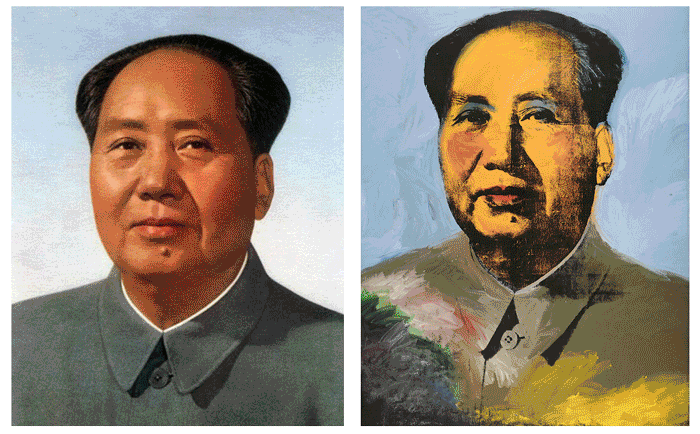
Andy Warhol
Source Imagery
Andy Warhol’s visual language gave birth to a new genre of art while permanently broadening the parameters of what constitutes an art object. His employment of commonplace subject matter and oftentimes appropriated imagery, created pictorial hybrids that have forever impacted the way in which society perceives the world. Throughout his wildly diversified and prolific oeuvre, Andy Warhol maintained a consistent creative formula characterized by Pop imagery, techniques in visual manipulation, his habitual method of silk screening, and a unique sense of color.
Andy Warhol was the first to champion a commercial aesthetic in the context of fine art. From his ten years of experience as a commercial artist throughout the 1950s, Warhol developed unique techniques in cropping and skills in visual manipulation often utilized in advertising to make imagery POP. Though Warhol’s hand painted work from the early 1960s utilized the human touch, his style quickly evolved to rely heavily on silk screens, mimicking the mechanic visual language often found in advertisements.
Warhol’s fluid transition from commercial work into fine art was closely linked to his study of not only culture, but American consumer culture, painting images and iconography that were both commonplace and intrinsic to everyday life. To many degrees, Andy Warhol was a sociologist, ever curious about the world around him.
Campbell's
Tomato Soup
Andy Warhol
Campbell's Soup Can, 1962
Andy Warhol
Campbell's Soup Can (Clam Chowder - Manhattan Style) [Ferus Type], 1962
Andy Warhol
Campbell's Soup Can (Pepper Pot), 1962
Andy Warhol
Campbell's Soup Can (Tomato Soup), 1962
In the early 1960s, determined to make the professional leap from commercial work into fine art, Warhol asked a friend what he could paint to make his work be taken more seriously, to which his friend replied, ‘Paint something so common that no one else would ever give it a second look’ – and voilà, The Campbell’s Soup paintings were born. Throughout the same conversation, the artist’s friend offered up one other suggestion, ‘Paint the one thing that you love most, paint money’.
Andy’s Campbell’s Soup Can paintings from 1962 were the genesis of an artistic paradigm he championed his entire career – a study of consumer culture, visual appropriation, repetition, and the beginning of his mechanized aesthetic. While the soup cans were hand-painted to simulate a mechanical, industrial appearance, the Dollar Bills series that followed almost simultaneously was one of Warhol’s earliest examples of visual appropriation coupled with the employment of his now eponymous silk screening technique.

Andy Warhol
200 One Dollar Bills, 1962
When Warhol discovered the process of silk screening, visual repetition took precedence in his work. Warhol’s appropriation of borrowed imagery played with the concept of deliberativeness, suggesting his appreciation and love of photography. From a single borrowed visual, Warhol explored repetition and scale, producing dozens, sometimes hundreds, of unique paintings based off one image; an artistic testament to why his studio was dubbed the ‘Factory’, where paintings were created on an assembly line similar in approach to how Ford was manufacturing cars.
Suicide (Fallen Body)
Source Image
Andy Warhol
Suicide (Fallen Body), 1962
Andy Warhol
Tunafish Disaster, 1963
Andy Warhol
Saturday Disaster, 1964
Andy Warhol
Suicide, 1962
Silk-screening began to operate as an extension of Warhol’s hand, revealing further authoritarian authorship to the images he was choosing to manipulate and reproduce. In 1962, Warhol began his Death and Disaster series, initially inspired by a newspaper photograph of a plane crash. Akin to the ‘normalcy’ associated with a dollar bill or Campbell’s soup cans, Warhol’s disaster series suggests that horrific events are all around us; everyone in a sense could be involved with or impacted by such catastrophes.
In this body of work, Warhol is in essence posing as a reporter, sourcing images from the most famous periodicals of the time, such as Life Magazine, The Daily News and the New York Times. While early examples within this substantial body of work include newspaper photographs depicting car crashes and suicides, one of the most famous visuals from Warhol’s Death and Disaster series is an image of an electric chair, devoid of all human presence. The chair depicted is based on a 1953 press photograph of the electric chair at Sing Sing Prison in New York; an image the artist reproduced in countless variations, denoted by scale, repetition and color.
Andy Warhol
Lavender Disaster, 1963
Sing Sing Prison
Electric Chair, 1953
Throughout this series, Warhol continued to explore the visual impact of pictorial reproduction, suggesting that when you see a gruesome image repeated over and over, they somehow lose their effect, mimicking how the media desensitizes the viewer through the repetition of tragic incidents. Warhol often chose colors that were at odds with the painting’s heavy source material to make the images more aesthetically pleasing – such was the case with ‘Lavender Disaster’ (1963), argued to be one of the most beautiful paintings throughout Warhol’s expansive oeuvre.
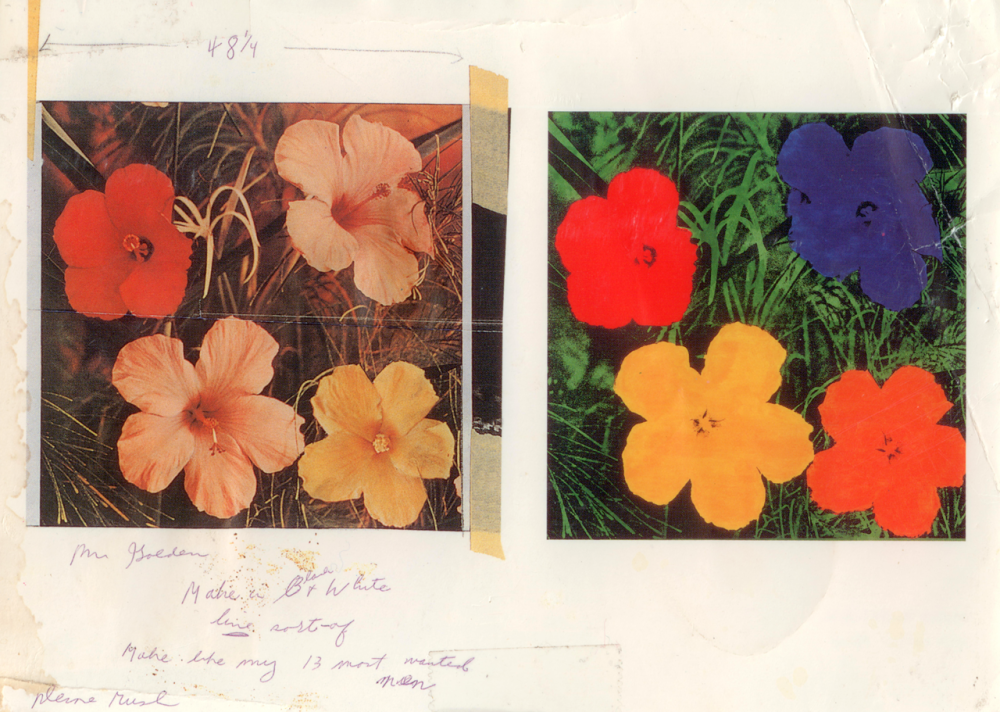
Patricia Caulfield, Hibiscus flowers, 1964 (L) Andy Warhol, Flowers, 1964 (R)

Patricia Caulfield
Hibiscus flowers, 1964

Patricia Caulfield
Hibiscus flowers, 1964
In 1964 Andy Warhol began work on his Flower series of 48- and 24- inch square canvases. The image depicted in these vibrant paintings was based on a color photograph of seven hibiscus flowers taken by Patricia Caulfield and published in Modern Photography magazine. The serial layout in which these photographs were presented appealed to Warhol’s sensibility, from which he cropped Caulfield’s original photo into a square format, manipulating the image’s composition to fit four flowers. In 1966, Caulfield sued the artist for unauthorized use, at which time Warhol began producing a variety of work based on photographs he himself took, giving rise to his wildly robust series of commissioned society portraits.

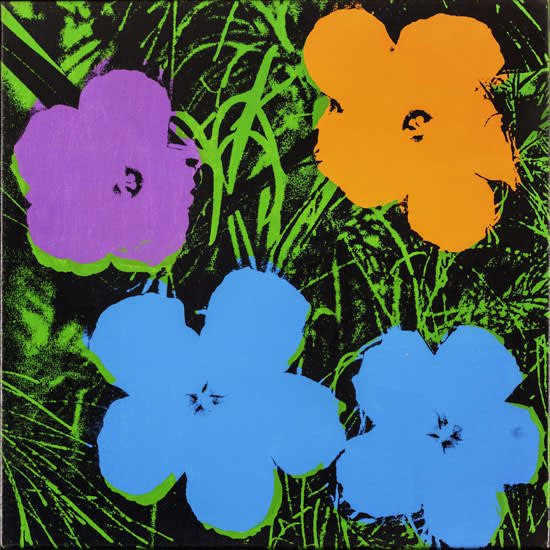
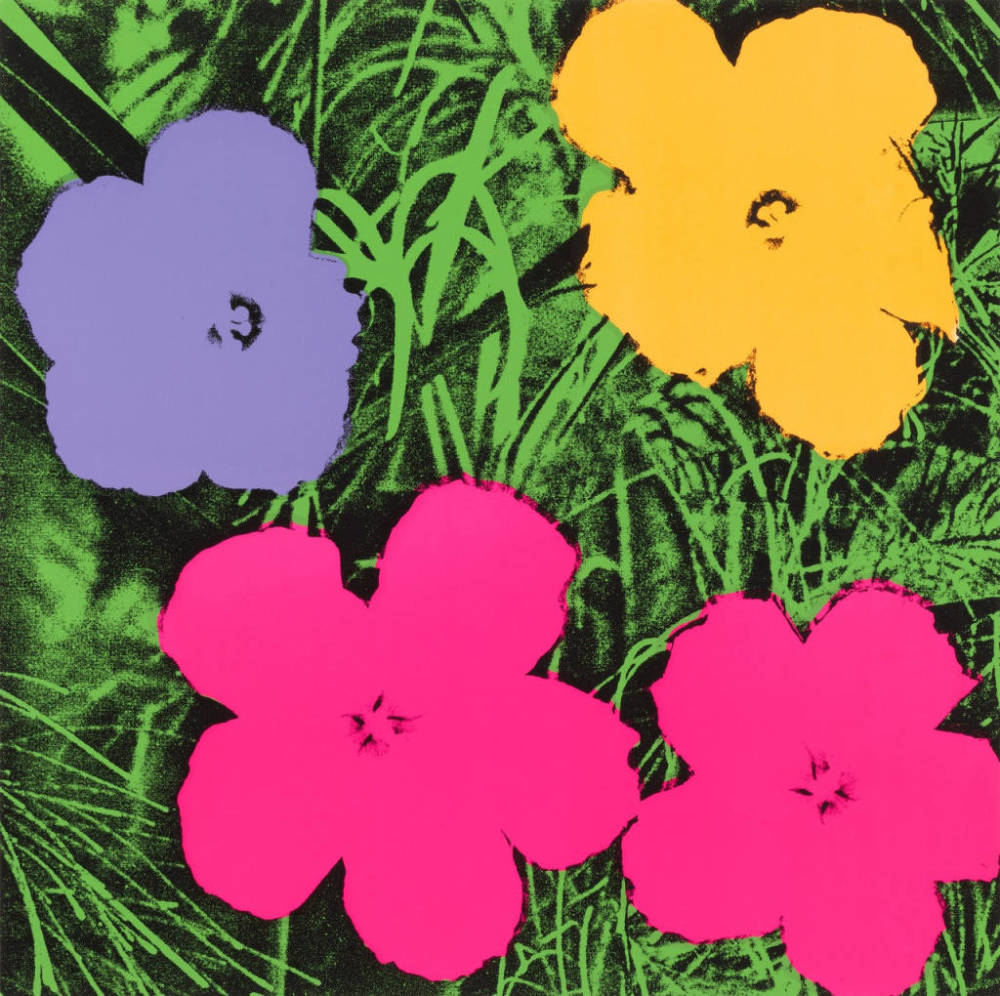
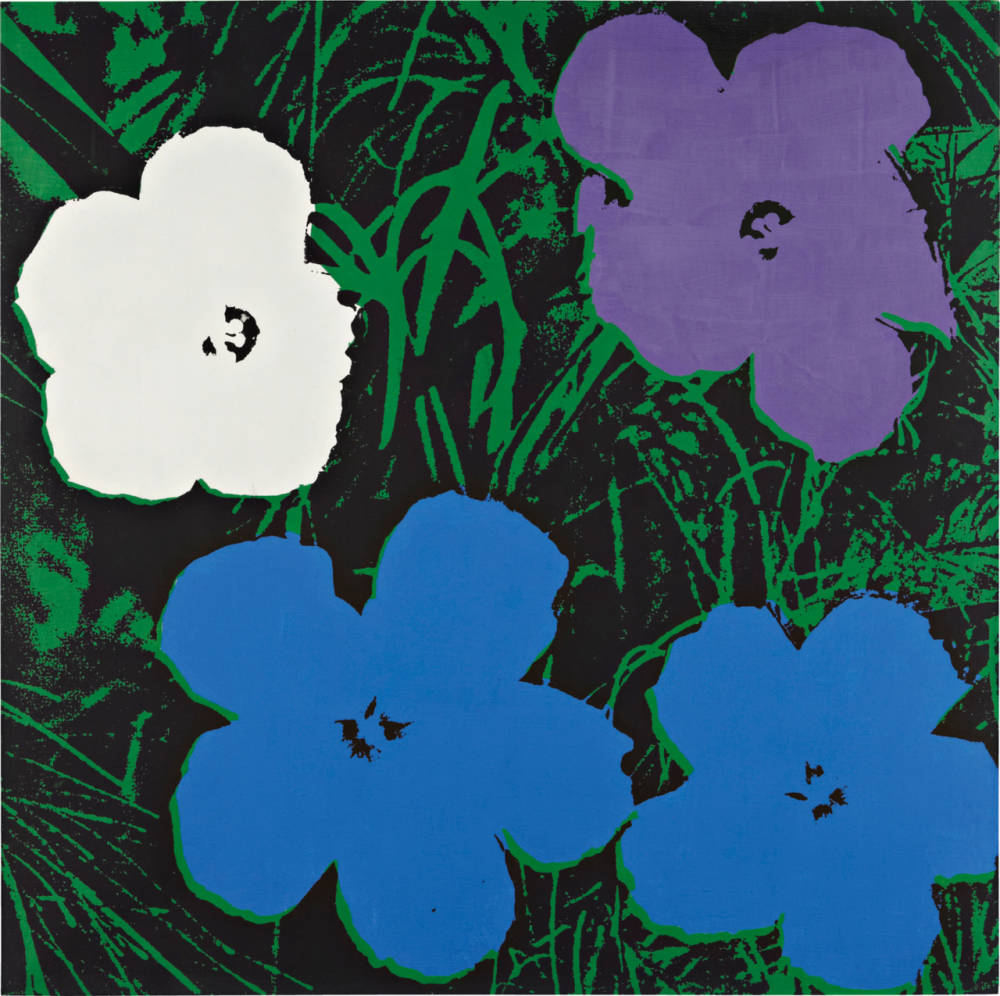
From the beginning of his career as a fine artist, Warhol focused on portraying highly circulated, familiar visuals that oftentimes spoke to his personal likes and desires. No subject being more enchanting and emblematic of Andy Warhol than the idea of fame.
Andy was infatuated with celebrity. Having grown up a devout catholic, Warhol portrayed his idols as modern day saints; his paintings were religious pictures for a secular culture. From the early 1960s onward, Warhol produced paintings of Hollywood film stars and pop-culture icons, from Marilyn Monroe and Elizabeth Taylor, to Elvin Presley, Brigitte Bardot and Marlon Brando. While countless celebrity portraits were captured by Warhol’s famous Polaroid camera, and later rendered as paintings, his earliest canvases depicting Hollywood stars were produced using appropriated movie stills and film reels.
Marilyn Monroe
Original publicity still for the 1953 film Niagara
Andy Warhol
Lavender Marilyn, 1962
Andy Warhol
Gold Marilyn Monroe, 1962
In 1962 Warhol began a series of paintings depicting Marilyn Monroe, shortly after the starlet’s death, based on a picture of the actress taken by Gene Korman for her 1953 film, Niagara. The image featured throughout Andy’s life-sized, 1960s portraits of Elvis Presley was a sourced publicity still for Presley’s 1960 Western film, Flaming Star.
Drawn to beauty as much as he was celebrity, Elizabeth Taylor was the air in which Warhol breathed and the subject of countless paintings. The artist immortalized Liz as both the young star in National Velvet and later as a sex goddess in Cleopatra, as well as through a series of cropped, single image portraits taken from a 1960s publicity still of Taylor. Likewise, in the early 1970s, Warhol executed a series of seductive paintings of Brigitte Bardot, in which the artist utilized a 1959 image of the French actress taken by famed photographer Richard Avedon.
![Andy Warhol, Liz #3 [Early Colored Liz], 1963](http://images.ctfassets.net/nonm77rtn1g8/5XPgWyF84wkS8EQC8aygSI/50274e59e970f2d20f16c5e0c23ce0b8/Andy_Warhol__Liz__3__Early_Colored_Liz___1963.jpg?w=1000&q=70)
Andy Warhol
Liz #3 [Early Colored Liz], 1963
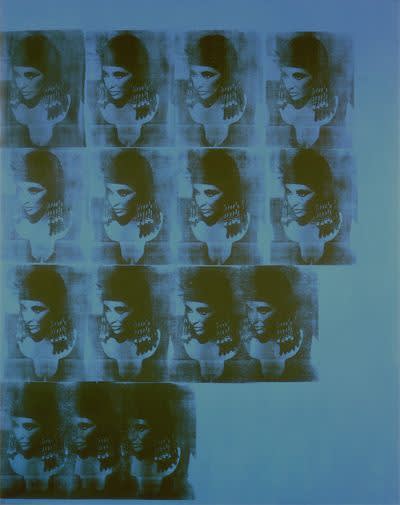
Andy Warhol
Blue Liz as Cleopatra, 1963

Andy Warhol
National Velvet, 1963

Richard Avedon
Brigitte Bardot, 1959
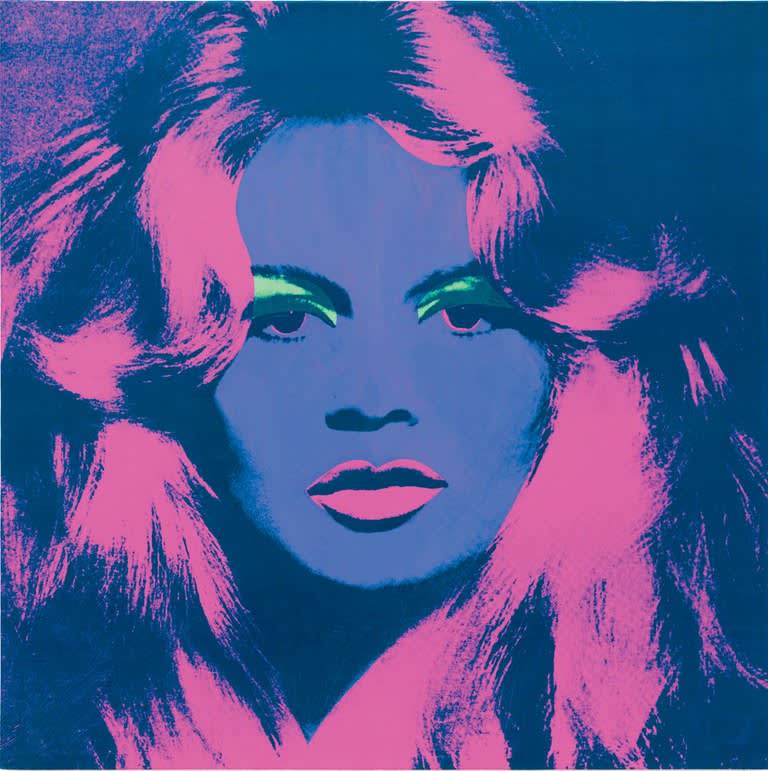
Andy Warhol
Brigitte Bardot, 1974
Throughout the 1970s Warhol’s obsession with fame grew beyond the parameters of movie stardom. In 1972, at the suggestion of gallerist Bruno BIschofberger that Andy make portraits of the most important figures of the 20th century, Warhol began a series on Chairman Mao, the leader of the Chinese communist revolution and founding father of the People’s Republic of China. After reading an article in Life Magazine proclaiming Mao the most famous man in the world, Warhol’s fascination grew and he began a series of large-scale paintings utilizing a visual by Zhang Zhenshi, created in 1950 for the first anniversary of the Communist take over of mainland China.
Zhang Zhenshi
Mao, 1950
Andy Warhol
Mao, 1972
Andy Warhol
Mao, 1972
Andy Warhol was in essence a journalist who worked in the medium of fine art, immortalizing imagery that captured the essence of time and culture. His career was as much a continuation of a visual aesthetic as it was a dialogue on modern thought. From cans of soup and dollar bills, to flowers and Hollywood movie stars, Warhol’s pictorial paintings redefined everyday objects and imagery, forever impacting the future of how, and what we perceive as art.


